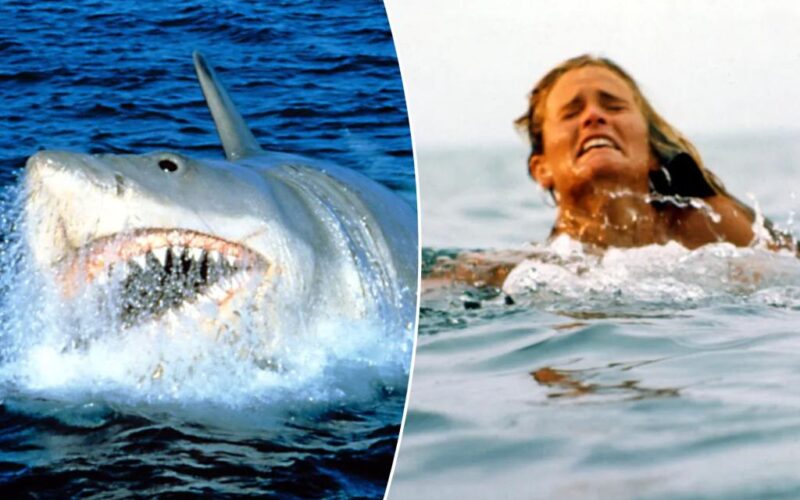Shark! Shark!
“Jaws,” which hit theaters 50 years ago next Friday, is known for making many splashes.
It was the first hit for a 27-year-old Steven Spielberg, the man who’d go on to become one of Hollywood’s all-time greatest directors.
And the innovative 1975 horror film is considered one of the earliest blockbusters. An estimated one third of Americans went to see it. Those are Super Bowl numbers.
There’s composer John Williams’ “duh-dun” score that everyone can hum, and the classic ad-libbed line “We’re gonna need a bigger boat” that everyone can recite.
But my favorite feat of “Jaws” is that the monster movie had such a powerful bite when it was released that it made the masses terrified to so much as dip a toe in salty water for months. Years!
No major films come anywhere close to that kind of impact today.
Sure, “Barbie” got groups of friends to get dolled up in pink frocks, and “Minecraft” pushed a few idiots to trash theaters for kicks on TikTok. But “Jaws” actually changed how people lived their lives.
During the summer of 1975, The Post wrote a lot of stories about the “shark scare” along the southern coast of Long Island, from East Quogue to Fire Island, that was “touched off by the movie version of Peter Benchley’s ‘Jaws’.”
“Jaws” was set in the fictional Long Island town of Amity. Suddenly, the real place was Sharksville, USA.
This one’s a real doozy. In August of that year, we reported that two police officers on a boat off Jones Beach encountered a 10-to-14-foot-long shark and started to open fire into the ocean — 15 rounds! — killing the fish.
Imagine watching that unfold from your folding chair.
“Everybody clapped. But when we left they were still standing on the shoreline,” one cop said of the Jaws-struck crowd.
“You know,” the wannabe Roy Scheider added, “if it weren’t for the movie, this wouldn’t be such a big deal.”
But, boy, was it. Scientists believe “Jaws” caused an entire generation to develop an irrational fear of sharks. They dubbed it “the Jaws Effect.”
And the fin-phobia extended far away from New York state. That same month in Carolina Beach, North Carolina, a tourism chief bemoaned, “We feel this movie is adversely affecting our coastal economy.”
Films can still hurt local economies today, of course. “Snow White” did because nobody went to see it.
The reverberations of 1970s smashes such as “Jaws,” “The Exorcist” and “Star Wars” were enormous beyond what we can imagine now.
Take the ingenious demonic possession picture.
One shaken man who saw “The Exorcist” in 1973 broke three ribs during a screening. He’s not sure how it happened. Ticket-buyers were vomiting at their seats. A theater in Boston kept “a stockpile of smelling salts” to wake up patrons who fainted.
William Friedkin’s landmark film went on to become a huge factor in the “satanic panic” of the 1980s, which saw thousands of unsubstantiated claims of satanic ritual abuse ripple across America.
Back then, blockbusters also rocked the Oval Office.
When President Reagan announced his 1983 Strategic Defense Initiative, a plan to use futuristic technology to prevent a nuclear attack, the press jokingly nicknamed it “Star Wars.” The moniker stuck.
I’m pretty sure we won’t be reading about “the Lilo & Stitch law” anytime soon.
Obviously, the world is different. “Monoculture,” entertainment that’s experienced by everybody, no longer exists. We’re inundated by niche fare and Saltine retreads. Maybe a movie just can’t pack the social punch that one could 50 years ago.
Then again, no one expected “Jaws” to explode the way it did. Implode, more likely. Production went 100 days over schedule and nearly $6 million over budget. Some thought its director would never work again.
But the next time you sprint out of the water screaming because that fin you saw turned out to be a cute little dolphin, blame Spielberg.







